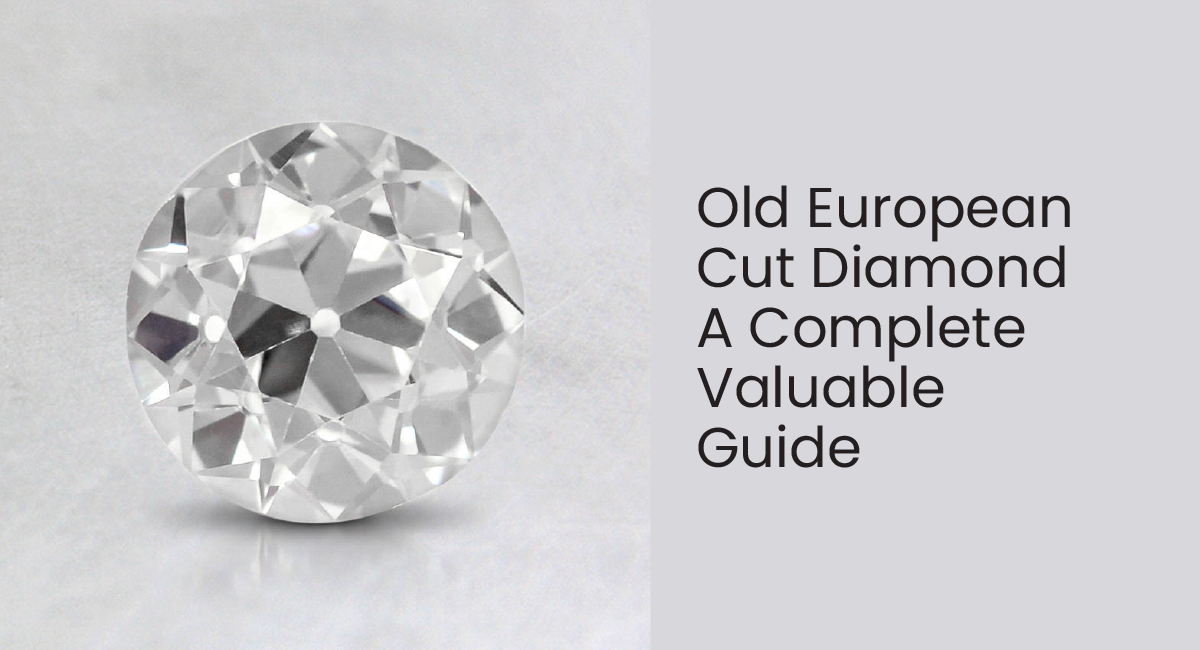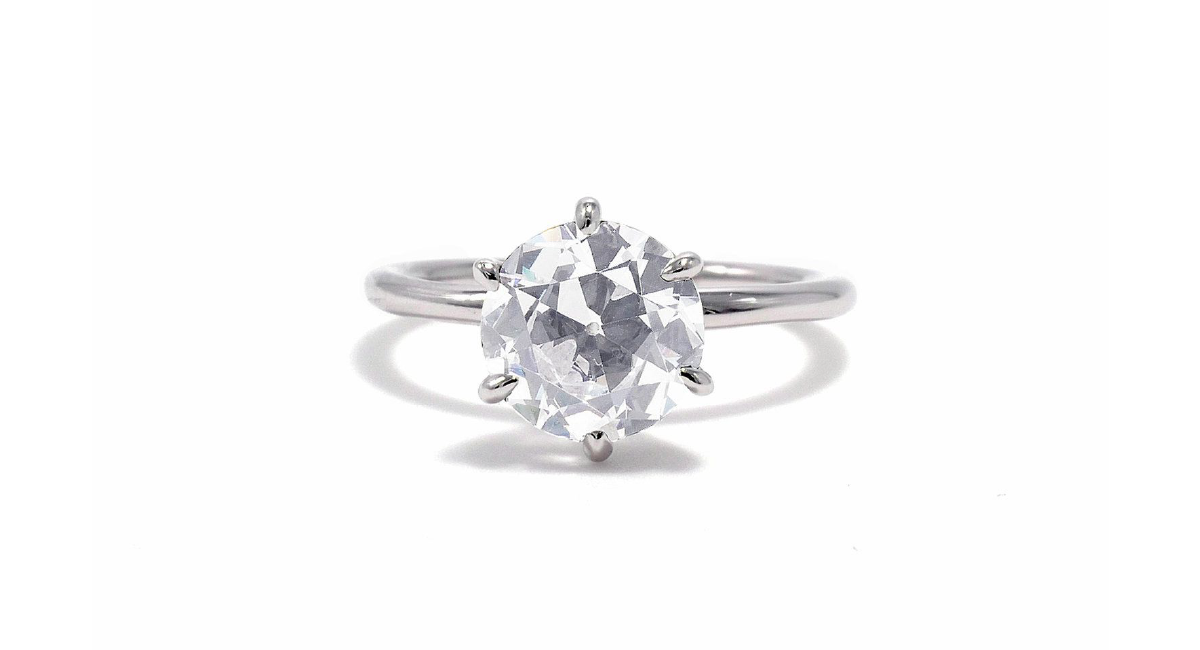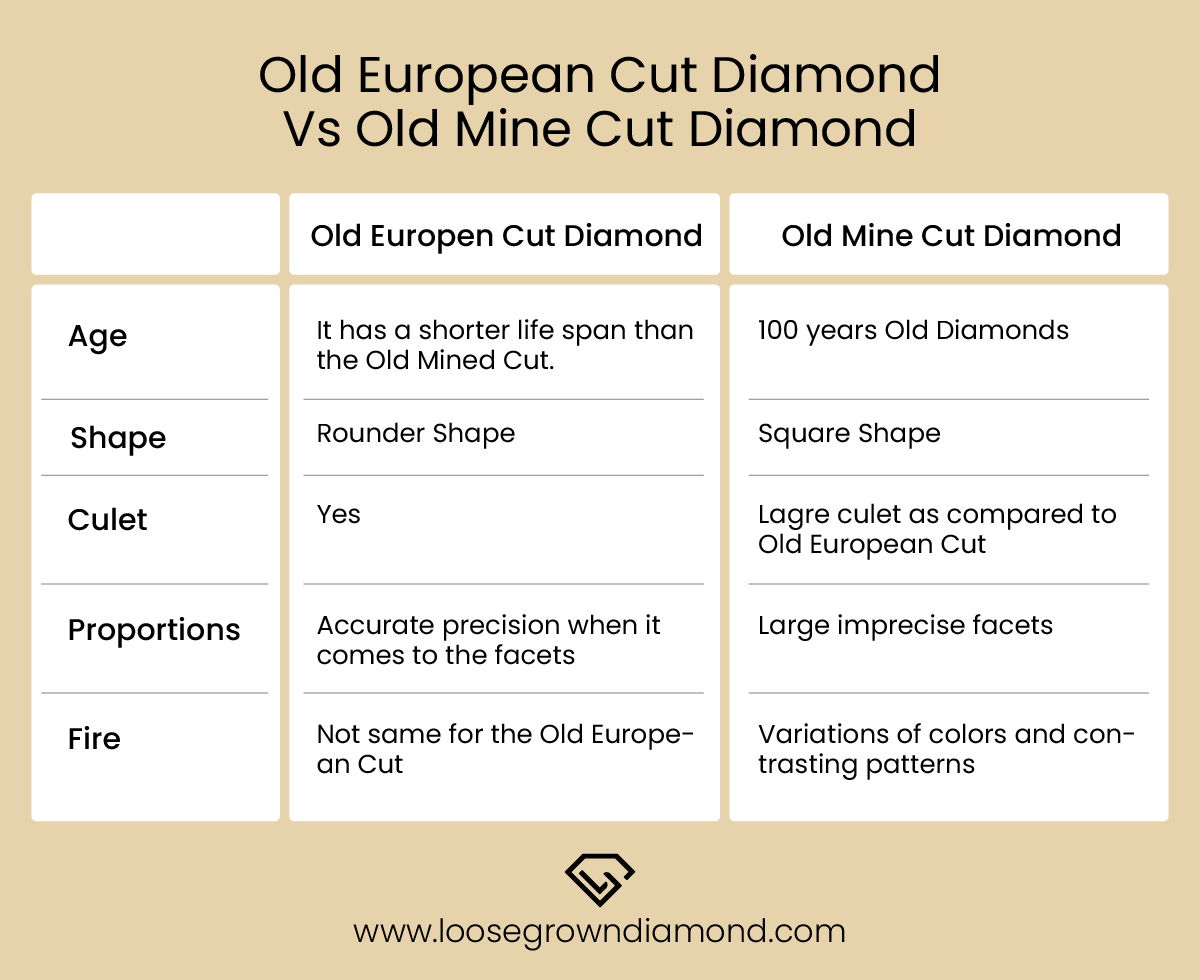What Is An Old European Cut Diamond – An Ultimate Valuable Guide
A diamond cutting process is a very complex process. Over time, the process has been optimized and is easier when compared to the old days. For that, technological advancements are to be thanked.
The development of new machines has helped a lot in enhancing the artistic capabilities of a lapidarist, due to which we have seen some great and brilliant cuts in the modern era.
And though people have greatly admired the modern brilliant cut, there remains a market that still appreciates the craftsmanship of the old antique diamonds. One such diamond is the old European cut diamond.
What Is An Old European Cut Diamond?
An old European cut diamond is an old and vintage diamond type that is different from the mine cut diamond. These diamonds were used to be cut between the late 19th and early 20th centuries using the old European cutting technique.
The old European cut diamond has recently been in the limelight because of many celebrities endorsing this antique and vintage style of diamond. This diamond cut succeeded the mine cut diamond whilst keeping some of its features. Which facilitates the argument of the old mine cut vs old european cut diamonds.

Some of these were the large cutlet and small table but having round shape.
These days with modern and high-efficiency machines, the diamonds are first scanned, and then it is worked out how the rough and raw diamond can be transformed into the piece of art that we are used to.
After that comes the cutting process, grinding and polishing, etc. Then the diamond is scanned again to see if everything’s cut properly or if any changes can be made.
The old European cut diamond was cut and measured to become the piece of art that it is today, using nothing but the cutter’s eye. The modern era’s way of cutting diamonds depends on both skill and heavy machinery.
But when compared to the cutting style of the old European cut diamond, it has an organic feel to it, containing all the imperfection and character, which when you notice you tend to appreciate the work that went behind creating that masterpiece. After all, it was made using nothing but the naked eye and human intuition.
Aesthetically the old european cut diamond is almost similar to the modern round cut diamond, so much so that it can be called the softer version of the modern round cut diamond. But the difference is clear to an eye that knows what it’s looking for.
Are Old European Cut Diamonds Valuable?
Speaking in general terms, no. As it is common for older diamonds to have less value in the market, the same goes for the old european cut diamonds. You can expect them to be 20% cheaper than the regular round cut diamond of the same carat weight.
But when we are talking about the general reality, the value of a diamond depends on a lot of things such as its clarity, color, carat weight, and cut. So naturally, there are a lot of instances where the prices of an old European cut diamond have been more than expected.
After that comes the rarity of the diamond. The diamond market changed a lot from when they used to make the old european diamond. And because diamonds are rarely being cut using this technique, such diamonds can be very valuable.

But again, for that to happen, the diamond needs to have certain admirable qualities that will encourage buyers, in turn, increasing its demand. Some of those qualities are if it has been cut and crafted beautifully or if it has any cultural or historical significance. Diamonds with these criteria in check often sell at a higher value.
To boost the price range you might be happy or sad, depending on your stand, to know that the old european cut diamonds are quite popular these days. Some of the reasons are soon-to-be-married couples.
Old European cut diamond engagement rings are popular among soon-to-be-married couples and if it fits the requirements of the couple then the price rarely matters. After all, the heart wants what it wants and the old European cut diamond ring is most likely to be of the same or cheaper price than a regular round cut diamond ring.
Shape
Carat
Cut
Color
Clarity
Price
old european
2.87
Ideal
F
VS1
$2083 $1984
View
old european
1.74
Ideal
D
VS1
$1413 $1060
View
old european
2.08
Ideal
D
VS1
$3117 $2338
View
old european
2.05
Ideal
F
VVS2
$1555 $1166
View
old european
2.79
Ideal
F
VS1
$2052 $1539
View
old european
2.00
Ideal
E
VS1
$1489 $1117
View
old european
4.09
Ideal
E
VS1
$3097 $2323
View
old european
4.09
Ideal
F
VS1
$3097 $2323
View
old european
4.11
Ideal
F
VS1
$3112 $2334
View
old european
3.05
Ideal
E
VS2
$2236 $1677
View
old european
2.13
Ideal
F
VS1
$1557 $1168
View
old european
2.02
Ideal
G
VS1
$1424 $1068
View
old european
2.10
Ideal
E
VVS2
$1683 $1262
View
old european
1.53
Ideal
E
VS1
$1213 $910
View
old european
4.01
Ideal
E
VS2
$3039 $2279
View
old european
2.03
Ideal
E
VS2
$1509 $1132
View
old european
3.08
Ideal
H
VS1
$1892 $1419
View
old european
4.04
Ideal
F
VS2
$3059 $2294
View
old european
3.11
Ideal
G
VVS2
$2301 $1726
View
old european
2.11
Ideal
E
VS1
$1565 $1174
View
What To Look For In An Old European Cut Diamond?
The old European cut diamonds are often compared with other antique diamonds such as the old mine cut diamond. But to no one’s surprise, they both are quite different in some areas. One of them is their large facets that are bigger than the round brilliant cut diamonds.
They can be easily spotted because of the small circle at the center on top of the diamond. That circle appears because of the large cutlet of the European cut.
A large cutlet is what allows light to pass through the bottom of the diamond creating dark rings in the process. Nowadays most diamonds do not have large cutlets or cutlets at all. The round brilliant cut diamond doesn’t have a facet at all.
Instead, modern diamonds have equipped themselves with more of a sharp end at the bottom, which also helps in reflecting the light and preventing dark circles from emerging altogether.
If you are looking to buy an old European cut diamond and are confused about what setting suits it the best. We would like to tell you that most people go with a simplified background. They don’t want any other design elements to shift the attention from their old antique diamond.
How To Identify An Old European Cut Diamond?
Old European cut diamonds were all handmade thus giving them a distinguished imperfection. This imperfection makes it easy to pick out an Old European Cut Diamond. This diamond cut has 58 facets (larger than regular diamonds) just like modern diamonds.

Most diamonds tend to also have large “culet” causing the light to escape which causes spots/circles to appear. Something that every diamond had in common was having a higher crown but a small table. The symmetry of the diamonds was very hard to achieve in Old European Cut Diamond due to antiquated vintage cutting.
Pros and Cons Of The Old European Cut Diamond
PROS
- Old European cut diamonds are often available at lower prices than modern-cut diamonds. Which makes them a good value for money if you’re into old and antique diamonds.
- The old European cut diamond is unique and not only when compared to other diamonds they are unique but also among their own kin. And that’s because every diamond is handcrafted. Which makes each one of them unique and a piece for appreciation.
- Their rarity is increasing because the older diamonds are being re-cut into newer and more modern shapes. As that transpires there will be very few original old European cut diamonds which is sure to boost the prices and the demand for the ones that are left.
- They also have something referred to as “inner fire” by antique diamond enthusiasts. Inner fire is the light and dark flashes of light in a checkerboard pattern. It’s less intense than the modern diamonds, which antique diamond enthusiasts appreciate.
- They make a perfect engagement ring as the demand for them is increasing. And for an antique engagement ring, the European cut, being antique itself, will be a flawless choice.
CONS
- They are very limited in numbers giving birth to limited choices. Because they belong to a rare antique type of diamond it’s quite hard to get them according to your color of choice, size, or carat weight.
- Imperfect cuts. As we have mentioned before the old European cut diamonds were completely handmade it is quite expected that they don’t have the perfect cuts. This certain con can also be a pro for you, depending on who you are and what you are looking for.
Old European Cut Diamond Vs Old Mine Cut Diamond
Old European Cut Diamond is often being compared to the Old Mine Cut Diamond, thus creating the ‘old mine cut vs old European cut– which is better?’ debate. while they both have a soft and supple appearance, albeit with few distinguishing features.

Age
When compared to the diamonds based on their age the Old Mine Cut Diamond is way older than the Old European Cut Diamond. Old Mine Cut Diamond is approximated to be 100 years older while Old European Cut Diamond became common in the 20th century.
Shape
Old European Cut Diamonds are rounder while Old Mine Cut Diamonds are square-shaped with rounded edges. Old European Cut Diamonds resemble the modern round cut diamonds and old mine cut diamonds incline more towards a modern cushion cut.
Culet
Old Mine Cut Diamonds and Old European Diamonds both have cults that are visible without any need for magnification. Although culet in Old Mine Cut Diamonds is larger when compared to Old European Cut Diamonds.
Proportions
Old European Cut Diamond has comparatively accurate precision when it comes to the facets. On the other hand, the Old Mine Cut Diamond has large imprecise facets.
Fire
Due to the large facet size of Old Mine Cut Diamond, it tends to display variations of colors and contrasting patterns. This isn’t the case when it comes to European Cut Diamond.
Both old European Cut Diamond and Old Mine Cut Diamond have a lot in common. They both are conventional pieces with imperfect symmetry, each having 58 facets and a smaller table compared to modern cut diamonds.
Old European Cut Diamond Vs Round Brilliant Diamonds
Modern Round Brilliant Cut Diamonds have evolved from old cut diamonds including Old European Cut Diamonds. They are similar in many ways but when compared side by side the differences are uncanny.

Table Size
The Old European Cut Diamonds have very small table sizes, sometimes as small as 38% of the diamond’s diameter. But Modern Round Brilliant Diamonds have excellent table sizes which go up to 60%.
Facet Shape
Both diamonds have similar facets (58 in number) but the cut in each varies. In the Old European Cut, the facet has a more triangular shape and on the other hand, a round diamond’s facet is thinner.
Culet Size
Because of the use of antiquated techniques, the culet size of the Old European Cut is larger than that of the Modern Round Cuts. The size recommended while selecting a diamond is to have no or very minimal culet.
Girdle Finishing
Unlike Modern Cut Diamonds that have faceted girdles, Old European Diamonds have frosted or brute girdles.
Precision and Symmetry
Usage of modern technology for making Modern Round Brilliant Cut makes it symmetrically precise but when compared to Old European Cut Diamonds which were handmade, the precision isn’t symmetrical.
Cut for Color and Brilliance
The modern round brilliant cut is designed for maximum brilliance, as the name implies. The old European cut, on the other hand, is predominantly intended to highlight the color of a diamond.
Where to Buy Old European Cut Diamonds?
The choice of where to purchase a diamond significantly influences the ultimate cost. Two primary options exist: online and in traditional jewelry shops. Opting for online diamond purchases can prove advantageous.
loosegrowndiamond.com offers old European diamonds at more affordable prices since they bypass diamond retailers and brokers, reducing buyers’ costs.
Utilize our diamond price calculator to ascertain the perfect value for your diamond. Unlock exclusive savings by applying our promo code, enhancing your diamond shopping experience with added benefits. Discover the find certified lab-grown old European cut diamond in our inventory.
Conclusion
Due to the rarity of Old European Cut Diamonds, the value has been constantly increasing. The value however depends on the color, clarity, carat, and cut. The downside of Old European Cut Diamonds is that it fall short on the “cut” aspect due to their uneven symmetry and lack of precision.
Having something valuable and antique-like Old European Cut Diamond can add brilliance, and color and amplify one’s diamond collection.
Frequently Asked Questions (FAQs)
Are old European cut diamonds conflict-free?
As previously stated, if you are searching for vintage bands (or contemporary rings with an ancient gem), the age of the diamond must imply that it is conflict-free. Antique crystals older than 50 years (pre-1970s) have always been conflict-free. More caution is necessary for more latest antique diamond engagement rings.
What is a European cut?
A round stone cut between 1890 and 1930 is known as an old European cut diamond. They were prevalent during the Art Deco era. These antique diamonds predated the contemporary round brilliant cut diamond, which has become the most pervasive diamond configuration. These antique diamonds have 58 facets, just like the popular diamond cut: Round.
How can you tell an old European cut diamond?
Old European cut crystals are distinguished by their prominent facets, which seem to be significantly more extensive than those of brilliant round cuts. They can be identified by the tiny circle in the center of the diamond’s table. The sizable culet of the old European cut inspired this ring. The culet is located at the bottom of the diamond.





